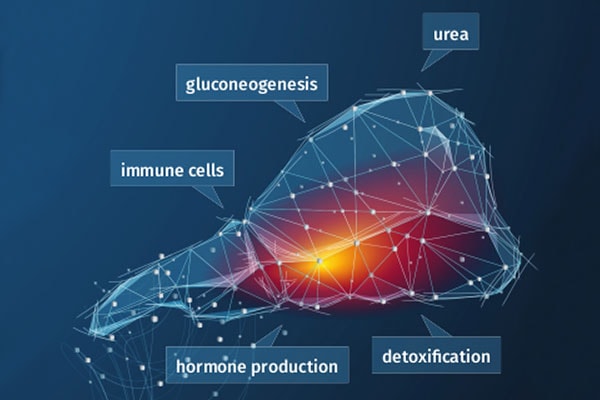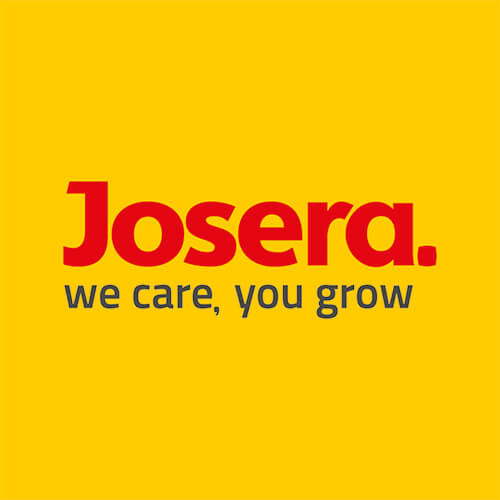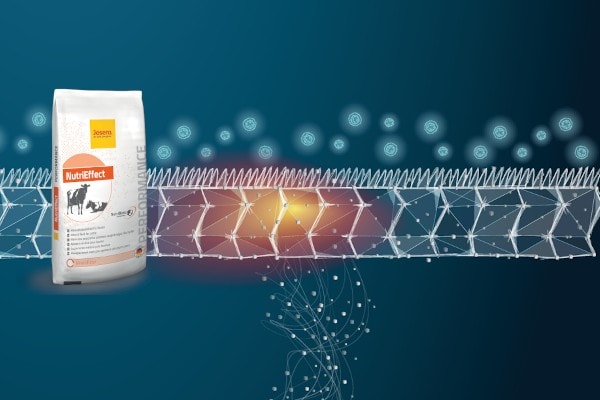- What is ketosis in cows?
- How can I tell if a cow has ketosis?
- How does ketosis develop?
- How much does ketosis in cows cost me?
- Caution fatty liver! What is the role of the liver in ketosis?
- DairySafe – so that the liver does not become fatty and sluggish!
- What is LSP?
- How does DairySafe work?
- How and when do I use DairySafe?
- What advantages does my herd have from DairySafe?
- What advantages do I benefit from as a farmer through DairySafe?
- What experiences have farmers had with DairySafe?
- Which JOSERA product line does DairySafe belong to?
What is ketosis in cows?
In veterinary medicine, ketosis is defined as the increased formation of acetone, a metabolic product, in the blood. Ketosis, also referred to as acetonemia, is a disorder of energy metabolism. It is the most important metabolic disease of the dairy cow and occurs 90% of the time during early lactation, the period with the highest energy deficit.
As the central metabolic organ, the liver is exposed to severe stress around the birth period (transit phase). A reducing feed intake is accompanied by an increasing need. This need can be very heavily or often not at all covered by the feed intake at the latest after the birth. A high-performance cow inevitably has to melt down body substance to compensate for the lack of nutrients.
In many animals in this case, the melted fat cannot be integrated into the energy metabolism because the glucose required for this is also deficient. As a result, the cow slides into a ketosis.
Ketosis is one of the most common metabolic diseases of today’s high performance cows and leads to considerable economic losses.

How can I tell if a cow has ketosis?
Ketosis can be divided into a sub-clinical and clinical phase. The following symptoms are not immediately visible in cows suffering from sub-clinical ketosis:
- firmer dung or diarrhoea
- no desire to eat
- weight-loss
On the other hand, the clinical symptoms are concrete and can directly indicate ketosis:
- acetone smell
- shinier and concentrated to disc-shaped dung
- wobbly walk
- nervousness
- aggressiveness
How does ketosis develop?
Feeding the high-performance cow is a tightrope walk between ketosis and acidosis. Because of the rapid increase in milk yield after calving, there is a high milk sugar release. There is also a high energy requirement for milk protein synthesis. The aim is to transform the negative energy balance into a positive one by the 50th day of lactation.
Cows are able to compensate part of the energy deficit by breaking down body fat. The use of body energy reserves of up to 25% is possible.
The rapid mobilisation of body fat promotes the development of metabolic disorders. Excessive mobilisation prevents the liver from metabolising all free fatty acids. The consequences are fatty degeneration of the liver and ketosis, which in turn favour other diseases such as mastitis, ovarian cysts, claw diseases, and endometritis.
How much does ketosis in cows cost me?
Financial damage due to ketosis is caused, among other things by …
- reduced feed intake,
- increased susceptibility to udder and claw diseases,
- poorer fertility,
- reduced milk yield
- and a higher culling rate

If a cow has ketosis, this can entail the following costs:
- a single treatment (infusion set, time, etc.):
| what? | how much? |
|---|---|
| glucose drench* | 5.00 € |
| propylene glycol (sodium-propionate) shot approx. 200 g | 1.00 € |
| Kexxtone Bolus | 40.00 € |
| ketosis treatment (veterinarian) | 60.00 € |
| calcium drench* | 5.00 € |
- loss of performance
- higher morbidity
- culling rate
- etc.
In total, costs of €200 to €400 can be incurred per ketosis and animal. If these costs are extended across several cows, it can lead to high economic problems.
High production potential of today’s genetics inevitably lead to a negative energy balance in early lactation. In this period the liver is extremely stressed. The consequence frequently is a ketosis or the development of a fatty liver. The liver is the central metabolic organ, as shown by the following figure.

An overloaded liver can no longer function properly. Therefore your cows become more vulnerable to disease – especially ketosis.
Therefore, it is important to protect the liver and to prophylactically prevent liver damage. Learn how this is possible in the next section.
DairySafe – so that the liver does not become fatty and sluggish!
The special feed JOSERA DairySafe with the LSP active ingredient package supports you so that the cow does not suffer liver damage.
DairySafe helps the liver to detoxify ammonia, form urea, detoxify bilirubin and detoxify medication.
In addition DairySafe leads to:
- lower susceptibility to disease
- better fertility
- higher feed intake for high performance
- lower culling rate
What is LSP?
DairySafe contains the innovative active agent package, LSP, the liver safety package.
A specific combination of rumen-protected active agents support the liver‘s functions. The excess fat can be removed or be metabolised better by the body.
LSP is the active ingredient package with biologically active substances that supports the liver function and stabilises the metabolism in the perinatal phase.
- concentrated effectiveness
- rumen-protected active substances
- synergy effects (physiological advantages)
- much cheaper than individual substances

How does DairySafe work?
DairySafe …
… reduces fat mobilisation
… supports gluconeogenesis and increases the blood sugar level
… degreases the liver and supports its performance
The following images make the effect clear.

Figure 1: The thickness of back fat in the transit phase could be increased by DairySafe.

Figure 2: The content of β-Hydroxybutyric acid in blood (BHB) could be reduced.
How and when do I use DairySafe?
DairySafe is a special mixture for cows:
- three weeks before until five weeks after birth: up to 200g per day/animal
- for the rest of the lactation period (up to 90 days): 100 to 200g per day, in order to support the metabolism and achieve high output
What advantages does my herd have from DairySafe?
- more efficient liver
- higher milk yield
- higher profit through healthy animals
What advantages do I benefit from as a farmer through DairySafe?
- the animals are much healthier:
- better fertility
- conservation and improvement of liver health
- high profitability
- more milk
- lower vet costs
- improved restocking
- you save time and money!
- €300 per ketosis (milk loss, treatment, complications)
- no metabolic and secondary diseases
- better fertility
- disposals due to metabolic problems
What experiences have farmers had with DairySafe?
Many farmers are already using DairySafe with complete satisfaction and the results are clear to see!
Ketosis and metabolic problems could be stopped on a Holstein Friesians farm in the Schwäbisch Hall district in Germany with 120 cows.
The challenge:
- Cows often suffer from ketosis and metabolic problems after calving
The Consequence:
- Decreasing milk yield
- High time and cost expenditure
- High use of medication
Solution:
JOSERA DairySafe is mixed into the dry ration
The result:
- Hardly any ketosis and metabolic problems, ketosis tests no longer necessary
- Consistently high milk yield
- Less effort for care and observation
Here you can find the entire success story of the operation as a video.
→ DairySafe improves the health status of the herd and brings time and cost benefits to the farm.
At a North Hessian farm with 600 Holstein Friesians, the ketosis cases were able to be reduced from 20% to 5%. The cows are now calving again and can be milked more easily.
What led to this experience?
Prior to the use of DairySafe, the animals were fed propylene glycol. With the help of a blood test, 20% of ketoses could be determined and documented in the herd management system.
DairySafe was then mixed into the total mixed ration 21 days before and 14 days after the birth of the cows with 200g per animal and day.
The result: the ketoses were able to be reduced from 20% to 5%.
In addition, 1.6 tons of expensive propylene glycol was saved.
The result:
Ketoses were reduced from 20% to 5%.
In addition, 1.6 tons of expensive propylene glycol could be saved.
Here you can find the entire success story of the operation as a video.
Which JOSERA product line does DairySafe belong to?
JOSERA DairySafe is part of the PERFORMANCE line from JOSERA. The products in the PERFORMANCE line are innovative, powerful and serve the achievement of ambitious business goals.
Read more about the various product lines and how they can be used here.
Are you interested in DairySafe and still looking for a suitable JOSERA dealer? Or do you have further questions? Then simply contact us via the contact form. We will be happy to help you!
You might be interested in the following contents:
JOSERA NutriBiotic – ensure intestinal integrity with functional animal nutrition
A key factor for biological performance is the health of the digestive tract. Especially in high performance cows with high feed intake, the intestine is forced to absorb more nutrients in a shorter time.
JOSERA DairyPilot – increase the milk yield of your herd now!
Is your operative goal to increase the performance of your herd? Or are the health and resilience of your herd important to you? Then read more about JOSERA DairyPilot!






 (2 Votes, average: 5.00 von 5)
(2 Votes, average: 5.00 von 5)
